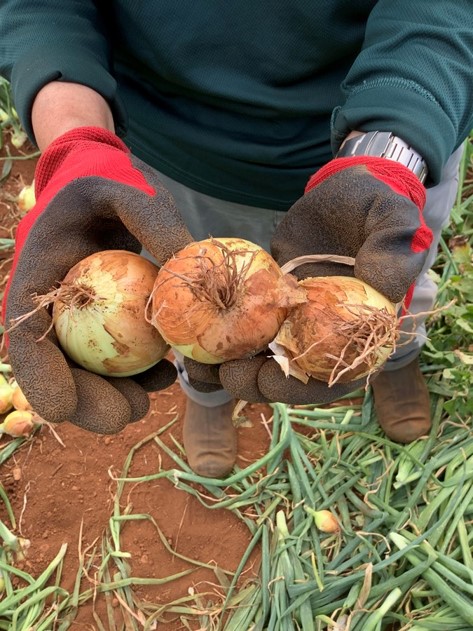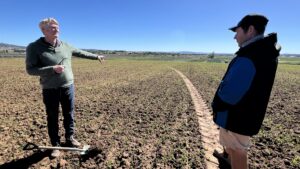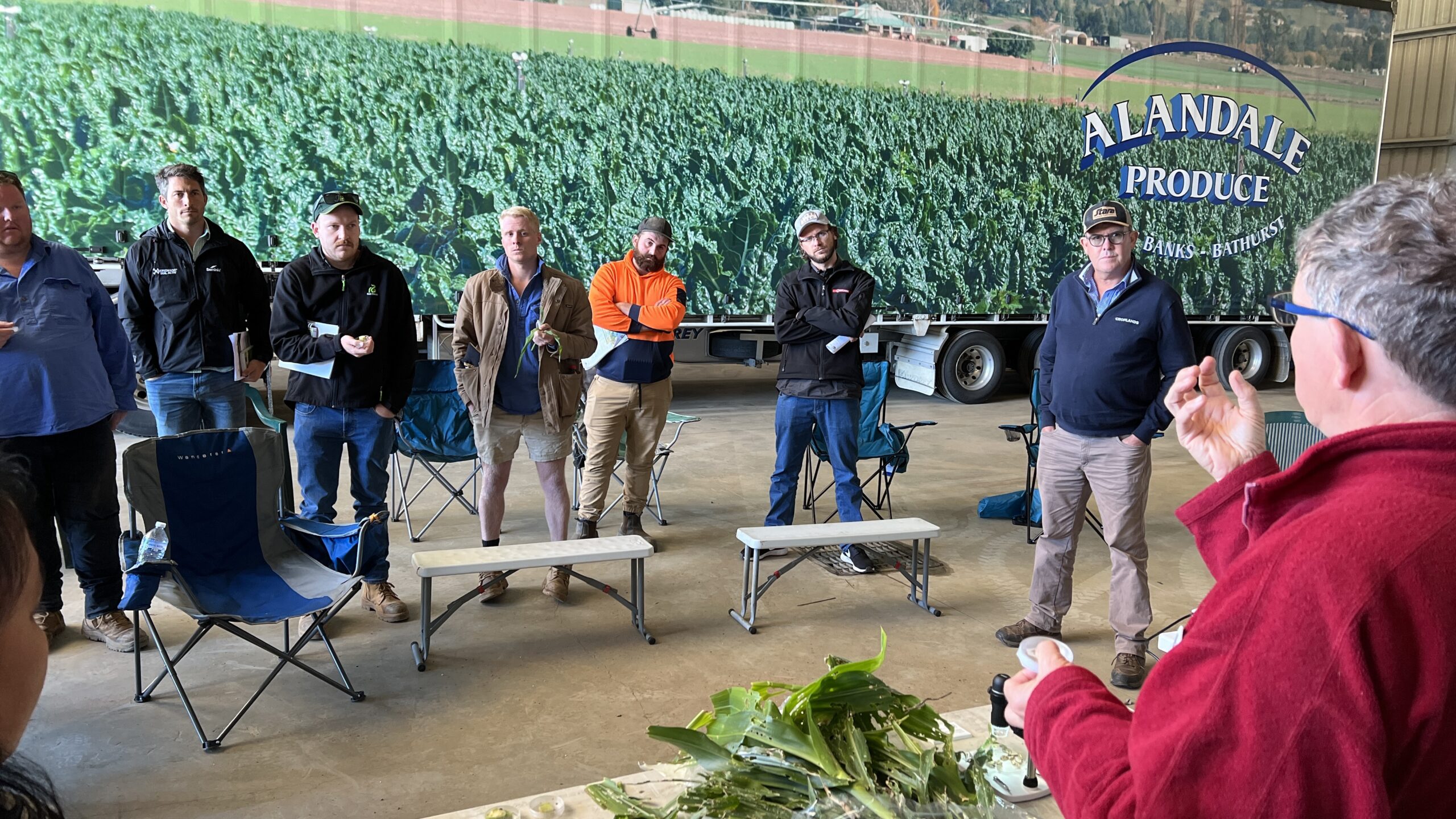
Grower input key to management of levy investments
24 May 2024
Developing strategies to inhibit Onion White Rot
24 May 2024Reducing farm biosecurity risks and better preparedness in the event of heavy and prolonged rainfall is the focus of the Building Biosecurity Capacity and Resilience within the NSW Vegetable Industry project.
Vegetable growers have faced additional challenges over recent years due to extreme or prolonged rain events impacting on various stages of crop production and farm profitability. While extreme weather events are generally outside the control of growers there are things that can be put in place to be better prepared, reduce risks and enable a return to production more quickly.
Local events run by AUSVEG as part of the Building Biosecurity Capacity and Resilience within the NSW Vegetable Industry project are bringing together growers, scientists and advisors to build knowledge and confidence to reduce farm biosecurity risks and be better prepared in the event of heavy and prolonged rainfall.

Andy Ryland of Integrated Pest Management Consultants monitoring the brassica crop
at the Greater Sydney Demonstration Farm for beneficials.
The program has taken the approach to deliver events and content based on local needs and circumstances, bringing experts and local advisors into the regions, to hold practical sessions on farm, and linking these topics to highlight biosecurity best practices. As well as directly damaging crops, excess water can also bring agronomic challenges and biosecurity risks, changes in pest and disease pressures, soil and water quality, and the movement of biological and other hazards via soil and water.
Focus for each region
A Community of Practice (CoP) for interested and engaged growers, agronomists and scientists has been established to share and discuss locally relevant issues that guide the focus of upcoming regional events. At the most recent CoP meeting Dr Sukhvinder Pal (SP) Singh, Senior Research Scientist, NSW DPI presented highlights from his research in improving food safety and traceability in horticulture. Dr Singh highlighted several commonalities in risks and best management practices between food safety and biosecurity, for example the risk of water and soil runoff in spreading soil or food borne pathogens.
Addressing local issues out in the field
AUSVEG led field days in the Sydney Basin, Cowra, Bathurst and North Coast regions with more to come in the second half of 2024.
“The field day programs included topics identified by the CoP, growers and advisors as locally challenging since the floods and erratic rain events over recent years,” said Project Coordinator Marguerite White. “Soil structure and compaction issues have been a concern because of water sitting on the soil surface for extended periods and from machinery working on wet ground.”
Simplot Australia’s farm near Cowra was affected when the Lachlan River flooded, causing yield variations across impacted blocks as well as loss of soil and riverbanks. Farms in the region also reported damage to spray infrastructure and soil compaction due to the large volumes of water. Other growers and advisors echoed the sentiment that it has had on yield, disease management and other farm activities.
At Alandale Produce near Bathurst, NSW, attendees saw first-hand how owners Val and Sam Micallef have integrated cover-cropping into their

Dr Kelvin Montagu, AHR discusses the
benefits of cover cropping on soil health with Val Micallef at Alandale Produce.
crop rotations, a practice that has built soil biology (e.g. fungi, bacteria, worms) with positive outcomes for soil structure and water infiltration. Cover cropping and the use of ‘brown fallow’ can reduce the risk of losing topsoil and support a more rapid return to cropping after flood events.
Stephanie Tabone and Kelvin Montagu from Applied Horticultural Research (AHR) explained how cover cropping can help to improve soil structure, increase organic matter and biological activity, water infiltration and water holding capacity. This was evident from the fungal mycelium and worms that could be seen when digging into the soil under the terminated brown fallow crop on the farm.
“With biology, we are trying to build these [soil] aggregates, so clumping together of the soil, which are more stable in water than heavily cultivated soils,” said Kelvin.
One of the consequences of poor soil structure is that if water penetration into the soil is limited, there is greater risk of runoff down the rows and erosion, and plants are more likely to be water stressed. Movement of water and soil can also move soil and waterborne pathogens, so practices that reduce this may have multiple benefits, including farm biosecurity for pest and disease management).
A very hungry caterpillar – the importance of monitoring and diagnostics
For sweetcorn growers and crop advisors, Fall armyworm expertise was a strong drawcard to the events. Fall armyworm appears to have been more prevalent in the Sydney Basin this season, possibly due to a summer of high humidity and higher rainfall.
The impact of Fall armyworm on sweetcorn plant development was evident in the samples that members of the Queensland Government’s Department of Agriculture and Fisheries (QDAF) extension team brought to the events. John Duff, Praise Tadle and Melina Miles (QDAF) showed that sweetcorn, planted at the same time as sorghum and maize, was much more stunted than the other crops, less able to recover from feeding damage.
What was also apparent was that destructive sampling is needed to truly know the numbers of Fall armyworm in the crop. Fall armyworm likes to hide – it can burrow in corn cobs and plants making it difficult to find. Evan Brown, Agricultural Manager, Simplot discussed how Simplot is managing Fall armyworm across their farms throughout the country, including monitoring and recording pests more broadly to implement management strategies.
Research continues into how best to manage Fall armyworm, including trapping efficacy, life cycle, the chemistry application on efficacy and rotation of chemistry to reduce the risk of resistance.
The Building Biosecurity Capacity and Resilience within the NSW Vegetable Industry project is also enabling vegetable growers and advisors to submit insect pest and diseased plant samples to the NSW Department of Primary Industries’ plant health diagnostic service to monitor and diagnose pests and diseases.
Further information
- Managing floodwater associated food safety risks in melon production and postharvest handling
- Managing on-farm biosecurity risks in wet weather events
- Spray water quality
- IPM and spray management
- NSW Vegetable biosecurity CoP Factsheet
- Plant diagnostic sampling guide
- Clubroot management in brassica vegetables
If you would like to join the Community of Practice, or would like more information about what you have read please contact Marguerite White (Project coordinator) at mwhite@icdprojectservices.com.au or Rosalie Daniel (AUSVEG Program Manager – Biosecurity) at Rosalie.daniel@ausveg.com.au.
A very big thanks to Sam and Val Micallef, Alandale Produce and Evan Brown, Simplot Australia for hosting the events. Thank also to Andy Ryland, IPMC, Leigh James, AgriWest, Stephanie Tabone, Sophia Thach and Kelvin Montagu from AHR, Sylvia Jelenik and Jonathan Eccles, VegNet for their support.
The Building Biosecurity Capacity and Resilience within the NSW Vegetable Industry Project is funded by the Australian and NSW Government’s Storm and Flood Industry Recovery Program with support from AUSVEG.
The National Fall armyworm Innovation System for the Australian Vegetable Industry project is funded by Hort Innovation using the vegetable research and development levy, Queensland Department of Agriculture and Fisheries, the Victorian Department of Energy, Environment and Climate Action and funds from the Australian Government.
Project VG22006
This event is also supported by AgriWest, Applied Horticultural Research (AHR) through the Soil wealth ICP project (MT22004), VegNet 3.0 (VG21000), NSWDPI Plant Health Diagnostics Service, Integrated Pest Management Consulting and Greater Sydney Local Land Services. The SFIRP project is coordinated by Marguerite White of ICD Project Services for AUSVEG.
This article first appeared in Australian Grower Winter 2024 magazine.

